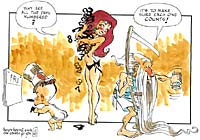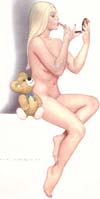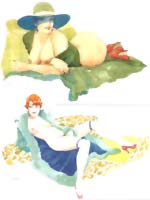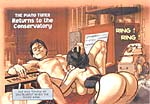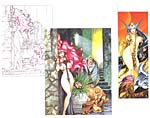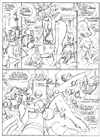 |
||||||||||||
|
Opus 130: Opus
130 (January
11, 2004). To start with, by way of properly commemorating the
arrival of yet another newly minted year, we examine, in the
spirit of the vintage "calendar girl" tradition, a
bevy of pin-up girls and other manifestations of feminine nudity
from recently published books. But the major event of this installment
is a round-up of some of the year's best editorial cartoons,
published here in defiance of Newsweek's annual desecration
of the genre. We also review two books we mentioned before-the
tomes memorializing Marmaduke's 50th anniversary
and Herman's 30th. And we browse, briefly,
the news of the day in cartooning. CALENDAR GIRLZ. A century ago, when I was young, adolescent and knew a good deal more than I know now, this time of year came equipped with a nimbus of cheesecake in the form of a fresh crop of calendars adorned with pictures of barely clad women. Actually, we began the harvest in November, as I recall, when the new calendars first began to appear on the magazine racks of the corner drugstore at 25th and Sheridan. Two or three different calendars, usually. And until Playboy joined the fray, the calendars were always painted pictures-by Gil Elvgren, Al Moore, Earl Moran, Harry Ekman, Edward Runci, Earl Mac Pherson, and many more. Playboy
changed the ritual by producing a calendar with photographs
of barenekidwimmin. Thankfully, the photos were copiously retouched
with airbrush, so the final product was not as far from our
coveted paintings of yore as you might otherwise suppose. By
way of reviving the spirit of those lost years, I'll sample
herewith a few of the present array of books picturing zaftig
ladies in their unadorned state. But first, a variation on the theme-namely
Frank Cho's Sketches and Scribbles: Book One (Monkey
Boy Press, 80 8x11-inch pages in paperback; $20 from Bud Plant,
www.budplant.com). The interior
consists of page after page of drawings of Cho's favorite subjects,
hairy gorillas, toothy dinosaurs, and bountiful young women,
somewhat unclad. Some of the drawings are pencils sketches,
usually preliminary renderings; others are completely inked,
final art. All display Cho's complete mastery of his medium.
The color cover is exquisite. It depicts in profile a nekid
lady, arrayed only with the flowers twined in her hair, sprawled
on the back of a gorilla, who is walking, as his species does,
on all fours, his back, therefore, being horizontal enough to
serve as the couch upon which the lady sprawls. The picture
is a study in texture: the woman's flawless pastel flesh contrasting
to the dark hairy arms of the primate. To this lovely arrangement,
Cho has, characteristically, added two touches of humor. First,
the woman is looking at us, with just the suggestion of a smile
on her lips, as if there's a joke here that we ought to be aware
of. Second, the gorilla is smoking a cigar. Until Cho's Shanna
the She Devil arrives from Marvel sometime in the forthcoming
summer, this may be the only Cho pin-up work you'll see outside
of Liberty Meadows. From SQP (www.sqpinc.com) we have a 48 9x12-inch
paperback entitled, with a flair for descriptive accuracy, The
Pin-up Art of Archie Dickens ($14.95 from Bud Plant and
elsewhere, including the SQP website and that of the Marianne
Ohl Phillips studio, www.moppinup.com). This is about
as close as we'll get here to the pin-up calendar of olden days.
About 44 full-page pictures in soft pastels of perky girls of
the nextdoor variety, all as naked as the day they were born,
playing with an assortment of props-telephones, diary books,
violins, pencils, costumes, small animals. Although the hair
color and style changes from page to page, the faces-and the
anatomy-stays the same: pouty, bee-stung lips, tiny turned-up
noses, full, firm and ofttimes pendulous young mamaries. An
extra attraction is a two-page biography of Dickens, who, born
in England, is, without question, the British Dickens we've
never met before. He did his first commercial work at age 14,
but it wasn't until about 1937, after he'd emigrated to New
Zealand, that he began limning the ladies in their embonpoint.
By 1939, he was in Sydney, Australia, mining the same vein.
After service in World War II, Dickens married and then, in
1948, returned to England, where he resumed painting pin-ups
until photographs replaced them as wall art. But the painted
variety has enjoyed a revival recently, thanks to Marianne Ohl
Phillips, and Dickens has been steadily undressing young beauties
since 1998. Now, at the age of 96, he's still at it. Phillips
provides a brief Foreword, extolling both the gentlemanly pin-up
artists she knows and their everlasting subject. She's talked
to Dickens many times over the last five years, she says, and
"just talking to him makes me enjoy being a woman." When she
asked Dickens why he always paints his pin-ups in the nude,
he said, "I rather prefer drawing girls without knickers." And
so, as Phillips says, he produces dozen upon dozen of "devilishly
naked young ladies with angelic faces." Says she:
"Perhaps because these pin-ups are painted by artists
with such chivalrous qualities, by gentle men who put women
on pedestals, these flirtatious ladies are sexy without being
offensive. No matter how naked, no matter how naughty, no matter
how enticing these beautiful creatures are portrayed, they never
look cheap or easy or overtly lewd." For something that veers off, slightly
but determinedly, in the direction of lewd, here's a volume
of watercolors and pencil sketches, The Women of Leone Frollo
(82 9x12-inch pages in hardback, from Bud Plant, $24.95).
In the Introduction by Luciano Spadanuda, we learn that Frollo,
born in Venice in 1931, gave up a career in architecture almost
at once to produce comics, of which, soon, most were of the
erotic variety (some of which are still available, in Italian,
through Bud Plant). For these, Frollo created such characters
as Mona Street and the ladies of Casino, a brothel. Some of
the latter, I suppose, show up here, posing unabashedly in a
moment of lustful abandon. In these pages of pictures, some
rendered in sensual pastel pencil and others in overheated watercolor,
we encounter the typical Frollo heroine, a voluptuous perfectly
formed and uninhibited young woman whose longing for sensual
pleasure she satisfies in trysts with other similarly inclined
ladies, all, we assume, residents of some 1920s bordello or
similar house of pleasure. Among these Sapphic lovers, no male
intrudes in this volume. Although Frollo delights in draping
his women with lace and ruffles and flowing robes and the frilly
undergarments of bygone times, these raiments are always slightly
askew and therefore more revealing than concealing. And none
of his women wear panties, apparently (a gesture at retro authenticity,
if we are to believe Spadanuda, who points out that this piece
of intimate attire is "historically quite new-only since the
mid-1800s have they been part of the female wardrobe")-at least,
they wear them no longer than is necessary for them to remove
them in as "wickedly" exhibitionistic a manner as possible.
The selection of pictures here is a charming and delightful
one, as immodest as the lusty women themselves. But for hugely entertaining lewdness,
here's The Piano Tuner from NBM's Erotica line (48 8.5x11-inch
pages in full color paperback, $10.95; www.nbmpublishing.com).
Noe's drawing style (on display previously in Ship of Fools,
Doctor I'm Too Big, and The Convent of Hell) is reminiscent
of Eric Sokol's fabulous color work in Playboy, except that
Noe works with a bold outline, decorative details in filigree
fineline, and modeling by varying hues of color. Mariano d'Elia,
the piano tuner, is called to various locales to tune pianos,
but he almost never gets to do any of the work because the wives,
daughters, maids, or secretaries of the personages who ostensibly
hire him need their instruments tuned first. Women of startling
embonpoint, they force themselves upon him, whereupon we witness
a couple pages depicting the most extravagant boffing wherein
the coupling participants assume every imaginable position.
And then some. Noe's depictions are both "explicit" and "graphic"
(as they say in all the adverts), but his visual inventiveness
is imaginative enough to achieve the near impossible: he manages
with aplomb the most contorted physical poses and, at the same
time, almost never repeats himself (which, considering the relative
monotony of the essential act he's drawing, is remarkable in
itself). Moreover, even the detailed rendering of genitalia
is accomplished with such skill that the pictures do not seem
at all gross or clinical. The appeal of pornographic comics (or
eroticomics, if you prefer something more euphemistic) is, presumably,
at least three-fold. First, we are curious about and therefore
attracted to depictions of the actual acts of copulation; second,
we are amused or otherwise imaginatively engaged by the "story"
that yields in these depictions; and, finally, we are pleased
by attractive artwork. The stories, here, are essentially comic:
d'Elia, while enjoying the pleasures of the flesh so frequently
thrust upon him, is almost always frustrated in the last analysis,
and in his frustration (not to mention the wantonness of his
partners), we find the comedy of each of these six short stories.
But for me, the artwork is the great attraction. Noe's drawing
style is marvelously engaging. His bold undulating outline captures
perfectly the fleshly aspects of voluptuous fornicating nudes;
and in other scenes throughout, his crisp lines and nuanced
colors are a pleasure to behold. But for undiluted pleasure in the beholding
department, do not miss any of the raft of full-color books
by Alonso Azpiri that have, in recent months, been flooding
the market. Azpiri, if memory serves, first surfaced on this
side of the Atlantic in issues of the regrettably short-lived
Penthouse Comix. Heavy Metal then published a couple
book-length stories: Lorna, the Mouse Club, and Lorna
and Her Robot. In the last year or so, Heavy Metal has published
Lorna: Leviathan, Wet Dreams and Wet Dreams II: The
Players, Lorna the Ark, Reflections (all of which are available
for the astonishingly low price of $14.95), Sketchbook
($19.95, a bigger book), and, from NBM, Sensations: The Art
of Alonso Azpiri ($18.95, another bigger book-well, longer,
more pages). A Spaniard, Azpiri has done a good deal of work
designing characters and album covers for videogames, but it
was for an Italian publisher that he began producing erotic
material. For a time, he did 240 pages a month for Italian publication,
and during this period, he discovered the value of simplification:
the simpler the drawing, the quicker it could be completed.
And this discovery, to hear him tell it (in Sensations),
led him to the female figure. "The key to [rendering] the female
form [is that] you need to eliminate lines, the faces and bodies
have to be simplified. I learned that the most important parts
of the female face are the eyes and the lips; of the body, the
hips and the legs; and that the motion should be feline and
elegant. ... I've always drawn with loving care, and tested
the boundaries between eroticism and pornography." The luminously colored stories in these
books, all by Azpiri, are science fantasy and involve bountiful
young wimmin, typically undressed, who travel in bordello-like
spacecraft, encounter strange wizards and monsters, and have
extravagant sex with them all. His most famous creation is probably
Lorna, a space adventuress, whose hair, like that of most Azpiri
women, streams from her scalp like a filmy veil caught in an
eddying current. But it's Azpiri's drawings that attract and
hold: exquisitely rounded, fully blooming bodies with bursting
bodices and bountiful bosoms (which are, usually, after bursting
the bodices, on ample, unencumbered display). Azpiri has given
"feminine" an idealized anatomy by utilizing every round shape
possible-a sentence packed with erotic emotion but without any
lexical meaning whatsoever. Enjoy.
NOUS
R US. "American
Splendor," the off-beat movie that combines actors and
their real life counterparts to re-enact portions of Harvey
Pekar's gritty, slice-of-life autobiographical comic book,
made it to the Top Ten lists in both People and Newsweek
magazines. ... I managed to witness three of those perennial
year-end lists of personages who departed our midst during the
past twelve-month, and Al Hirschfeld, the legendary theatrical
"characterist" (as he called himself), was listed
in two of them; but Bill Mauldin, the WWII soldier cartoonist
whose Willie and Joe cartoons revived flagging spirits in foxholes
everywhere, was mentioned nowhere I saw. ... Lenny Bruce,
the fearlessly foul-mouthed stand-up comedian of the sixties
who was convicted of "giving an obscene performance"
in 1964 (two years before he died), was pardoned December 22
by New York Governor George Pataki, who was responding to petitions
from lawyers and comedians who felt the man who helped transform
comedy deserves a better legacy. ... Madonna, apparently
transfixed by her success as the author of a couple of children's
books (which made motherhood, for her, a commercial asset, but
which, were her name, say, Louise Ciccone, would have sold nary
a volume, I'd say), will play a fairy godmother in the movie
version of her first opus. ... According to the Comics Buyer's
Guide, the year 2003 saw the establishment of three records:
Sandy Eggo's Comicon International was the largest of its kind,
ever, using 90% of the gigantic bayside convention center; Heritage
Comics collected $4.2 million in the largest sales total for
a single comics auction; and DC's Detective Comic retained
its status as the longest-running comic book title, ending the
year at No. 789. ... A letter-writer in the Sioux City (Iowa)
Journal, while "refusing to argue with a duck or a
so-called comic strip writer," pointed out that Mallard
Fillmore and Bruce Tinsley "make a hobby of insulting
the more than one million educators who belong to the National
Education Association." The strip, saith the scribe, is
"consistently mean-spirited and humorless" when it
asserts, as it has on more than one occasion I gather, that
NEA means "No Excellence Around." You get nowhere
attacking teachers, Bruce: they have all the chalk. Editorial Cartoonist John Sherffius
quit his post at the St. Louis Post-Dispatch on about
December 10. Although both the paper and the cartoonist said,
or strenuously implied, that his departure was his idea and
did not reflect any ideological differences (both the cartoonist
and the paper are liberal-leaning), both also allowed as how
his work was no longer "a good fit" for the paper,
which sounds like some sort of ideological mismatch to me. Sherffius
joined the P-D five years ago, the winner of an unprecedented
but acclaimed talent search conducted, in part, by Pulitzer-prize
winning editorial cartoonists from other newspapers. The cartoonist
will continue self-syndicating his cartoons to other publications,
but since he plans to stay in St. Louis and spend more time
with his family, it's unlikely that he'll find a full-time berth
at any newspaper. Echoes of ancient history. During
World War II, G.I. readership of comic books was so enthusiastic
that it bumped up circulation for the four-color fantasies by
millions, and now, maybe it'll start happenin' again. A Michigan
comic book shop, Mr. Dale's Tradin' Cards in Eaton Rapids, sent
a box of comics and trading cards to U.S. troops in Iraq, and
the box wound up gathering dust in a corner of a field hospital
in southern Iraq. Discovering the cache, a member of the hospital
staff promptly distributed the contents to the wounded, saying,
later: "It's quite a sight to see hardened military professionals,
young men and women recuperating from injuries or illness, in
bed with a Batman comic debating who would win in a fight, Batman
or Wonder Woman." I've watched the return of Opus with
great interest, but, so far, I'm disappointed. I've also been
reading the online re-run of Bloom County since it started
last March at Uclick's www.MyComicsPage.com, where it appears
at the accelerated rate of six dailies one day, then a Sunday
strip the next day, then six more dailies on the following day,
and so on. We're now well into the strip's third year, and it
seems to me that Berkeley Breathed was much funnier then
than he is these days with Opus. For the first three-four
weeks of the Sunday only strip, Breathed has been belaboring
the conceit that Opus, after his job at the strip disappeared
in 1995, trekked off to Antarctica, where, for the past eight
years, he's been alternately day-dreaming about toothsome damsels
of the homo sapiens species and resisting his mother's attempt
to marry him off to a fat penguin. The connection to the real
world culture that surrounds the strip is wholly, thus far,
overlooked. Breathed is doubtless just warming up, revving his
creative engine, so to speak, in an effort to get back to speed.
But I'm not sure his brand of topical humor will work on a once-a-week
basis: Bloom County charmed us in part because it accumulated,
day by day, an ambiance-a combination of the characters' personalities
and their various reactions to society around them-that was
soon both familiar to us and satiric in its comment on our culture.
We could expect Steve Dallas to say something loutish when approaching
the school marm Bobbie; we knew Binkley kept his anxieties in
the bedroom closet; we knew Milo would use his newspaper position
to persecute politicians. Every day's strip arrived freighted
with what had gone immediately before, and all of that weight
imparted to each installment a momentum that gave every barb
Breathed flung an impact it couldn't have without the accumulated
history. Whether that sort of ambiance can be created and then
sustained with just one appearance every seven days remains
to be seen. But we're here, rooting for the winsome flightless
bird-even though I think his beak is much much too big. (Geez,
he's no longer cute, Berke.) And we're rooting for Breathed,
too, even though he ofttimes behaves like a self-absorbed lout,
much in the manner of the aforementioned Steve Dallas. Funnies
Watch.
Just before Christmas, Norm (in Michael Jantze's strip,
The Norm) got "downsized." That is, he lost
his job. At his exit interview, he said he wanted to talk to
the president. "Uh, he didn't come in today," said
his interviewer. "Not that goof," Norm says, "I
mean Mr. Bush." Right: the guy responsible for all the
downsizing from sea to shining sea. Sarcasm turns to happy satire
a week later when Norm wanders off in a snow storm, seeking
"sage advice." He encounters the precocious savant
Jason from Foxtrot ("Why are you asking me? I'm
prepuberty"), Calvin from Calvin and Hobbes ("Go
away! Leave me alone!"an allusion, doubtless, to Bill
Watterson's notoriously reclusive proclivity), and Cathy
from Cathy (who babbles on in a multiple-syllable but
single-word sentence that suggests the hapless woman's ceaseless
hysteria at the seeming idiocies of modern life-well, of shopping,
mostly). Baffled at each of these encounters, Norm plunges back
out into the snowstorm: "Still searching," he says.
Nicely done: a central characteristic of each of the three strips
is evoked in a single picture and speech. And then in Heart
of the City, young Heart tries to restore the Christmas
spirit in her mother, who, over-scheduled by the holiday, hasn't
entered into the spirit of the season at all. Her mother falls
asleep, momentarily exhausted, and appearing in her dreams are
old Scrooge, Linus, Rudolph the Red-nosed, an elf I don't recognize,
Frosty the Snowman, the Grinch, and Lucy Van Pelt. Saith the
mother: "I'm being haunted by the ghosts of tv specials
past." And on the next day, she realizes that "the
ghosts of Christmas tv specials past came to teach me the true
meaning of Christmas-pithy tales of redemption and saccharine
sentimentality! Thank you, thank you," she cries, and,
throwing open the window, shouts into the night: "Merry
Christmas!" To which Frosty, leaning out of the tv set,
says, "And God bless us everyone!" YEAR
IN REVIEW: EDITOONERY AT WORK. Near the end of every year, Newsweek magazine produces a special
expanded "Perspectives" section in which editorial cartoons
and quotations from the famous and the infamous are herded together
by way of reviewing the events of the previous twelve months.
This year, perennially reliable as always, the magazine has
again disgraced itself in its selection and treatment of editorial
cartoons. In its treatment, Newsweek is shamefully cavalier:
although it clearly values the commentary of the visual artist,
the magazine apparently sees the cartoons as wall hangings rather
than as statements by opinion-mongering cartoonists. The cartoons
are therefore treated as all other visual material in the magazine-which
is to say, the cartoonists' signatures are perfunctorily excised
from the cartoons and the authors are given credit in marginal
7-point type much as photographers are. Newsweek's columnists,
the other commentators in the magazine, are given the courtesy
usually extended by the journalistic fraternity to the mongers
of opinion: they get bylines. In its selection of cartoons for this
grandiose display, Newsweek reveals, as usual, its disdain
for cartooning. It publishes mostly the cartoons that provoke
laughter rather than thought. In this, it reveals all the discernment
of the typical newspaper reading ignoramus who, seeing a cartoon,
expects it to be funny and only funny and is therefore highly
offended if an editorial cartoonist chooses to comment in some
fashion on an event that is not fodder for a Jay Leno monologue-mass
murder, for example. At least this year, the magazine did not
include cartoons from The New Yorker, by which maneuver,
last year, it tipped its hand, revealing its editors as ignoramuses.
Editorial cartoonists these days do not always, day after day,
produce hard-hitting material; they vary their treatment of
the day's headlines, sometimes going for a laugh instead of
a larrup. Newsweek goes for the laugh, too-every time.
Not only that, but the magazine overlooks many of the major
events of the year by not including a cartoon on those matters.
Some of those events, admittedly, are recognized with quotations
from celebrities rather than cartoons, but since the visuals
are the more attention-getting, the occurrences commemorated
with quotes alone are thereby slighted. The major events of the year 2003 are
mostly subsumed under the Iraqi adventure-the actual invasion
of the country, but also the debate about whether the invasion
was justified, the refusal of France, Russia and Germany to
back the U.S., the looting of Baghdad and, subsequently, the
evident failure of the U.S. war planners to plan effective postwar
procedures*, the failure to find the weapons of mass destruction*
that had, ostensibly, provoked us to invade to begin with, the
faulty intelligence upon which our decision-making was apparently
based, the increasing guerrilla resistance in Iraq, George W.
("Whopper") Bush's request for $87 billion to finish the job
(or just the year), and, at last, the capture of Saddam himself.
But in addition to the invasion of the benighted Saddam's country,
the year included such other significant events as Kim Jong
Il's nuclear saber-rattling, the disintegration of the space
shuttle Columbia, the charade of the Homeland Security Department,
Congressional approval of yet another gigantic tax cut for the
wealthy as well as a partial-birth abortion ban and the muddled
addition of prescription drug benefits to Medicare, a monster
power outage in the northeast, Israel vs. the Palestinians,
Gray Davis' recall as governor of California and Arnold Schwarzenegger's
election* to take his place, the accumulation of nine candidates
for the Democrat presidential nomination (with the virtually
unknown Howard Dean emerging as the so-called "front runner"*),
the Dow-Jones topping, once again, the 10,000 mark, the SARs
epidemic*, and the continued liberty of Osama bin Laden.* The
media this year also paid undue attention to such comparatively
trivial events as Kobe Bryant's womanizing, Scott Peterson's
perpetual trial, Michael Jackson's proclivity for young boys*,
Elizabeth Smart's disappearance and then reappearance, William
Bennett's gambling habits*, Rush Limbaugh's drug habits*, the
New Hampshire Episcopalians' naming a gay bishop*, Massachusetts'
encouragement of same-sex marriage*, Mel Gibson's movie about
the death of Christ being anti-Semitic, the on-again-off-again
wedding of Ben Affleck and Jennifer Lopez, CBS cancelling a
movie about the Reagans, and reality tv. In this catalog of mischief, Newsweek's
selection of cartoons touched upon only those topics I've marked
with an asterisk. Of the 23 cartoons published, only 5 dealt
with subjects I've listed here as fairly major events; but in
the relatively trivial category, Newsweek published an
equal number, showing, apparently, an inability to tell the
significant from the insignificant. Quite apart from the skewed
news judgement these choices demonstrate, the major events not
cartooned at all seem to me to constitute a signal indictment
of Newsweek as a news magazine. Newsweek ignores the
continuing tragedy in the Middle East (between the Israelis
and Palestinians, I mean, not in Iraq, although that disaster,
too, is largely overlooked), the environment, the debate over
invading Iraq, and the loss of jobs in the U.S. By way of trying to make up for Newsweek's
nearly criminal abdication of journalistic responsibility, I've
assembled my own gallery of cartoons on the events of 2003.
Alas, not every subject I've identified here as important is
reflected in my selection: throughout the year, I clip cartoons
I like, but I didn't clip cartoons with this review-of-the-year
purpose in mind, so I missed a few topics. I usually clipped
cartoons that I regard as particularly hard-hitting or exemplary
of the genre's deployment of visual metaphor, so these cartoons
are representative of the best editorial cartooning around.
In a few cases, the commentary is achieved by exploiting the
capacity of the medium for timing (in a sequence of pictures,
like a comic strip), but my favorites tend to be powerful images
coupled to telling verbiage, the pictures and the words together
creating a memorable statement that lodges in the brain. And
most of these are hard-hitting, too-their creators went for
a statement rather than a laugh (although sometimes the cartoon
provokes laughter as acerbic as the statement is uncompromising).
Here we go:
In the backseat of the car at the drive-through
Hamburger Haven, Marmaduke barks back at the "Order Here" squawkbox,
and Mrs. Winslow says, "Hush, Marmaduke: I did the ordering." Marmaduke goes with the family to visit
Santa Claus, but Santa, eyeing the size of the dog, explains
to the kids, "No, he can't sit on my lap and tell me what he
wants for Christmas." The Winslows are still abed and the
sun is just peeping up over the neighborhood housetops, but
Marmaduke is bedside with a leash in his mouth, eager to greet
the day. Phil says, "If you slept late once, I'm sure you'd
like it." Marmaduke is barking in consternation,
and Phil explains: "He is so spoiled! Just because I wouldn't
put a slice of lemon in his water dish." And here, in a hilarious tableau, is
Mrs. Winslow astride a sleepy-eyed Marmaduke, a grocery bag
on one arm, the other desperately embracing the dog as they
both come in the front door; she explains this contortion to
Phil, who, puzzled, meets them at the door: "He stood up just as I was stepping over him." In addition to Key, Anderson counts
among his influences J.R. Williams (Out Our
Way), Hank Ketcham (Dennis the Menace), and
another old time magazine cartoonist, John Gallagher,
whose distinctive flat-footed, bulbous-nosed, lanky characters
could once be found in every magazine in the country. "I try
to balance words and art in Marmaduke," Anderson said,
answering the question which was more important, words or art.
"That doesn't mean the two have equal weight. The gagline complements
the cartoon ... or provides a surprise! Marmaduke leans
heavily on action; Marmaduke cartoons are first and foremost
visual. Think of the old Laurel and Hardy movies: they began
as silent comedy, doing everything through action. Later, when
talkies came in, dialogue became a part of their comedy, but
the visual stuff was always there." Jim Davis (Garfield)
supplies an Introduction, but the rest of the book is all
Anderson and Marmaduke. In 160 pages, not much to show for 50
years-but what's here, as Spencer Tracy used to say of Katherine
Hepburn, is "cherce." (By which he meant, "choice.") I also mentioned some time ago that
Jim Unger's Herman was enjoying its 30th
anniversary by being reprinted in a lavish series of five giant
tomes, the first of which is now out. As a history of the feature,
the book leaves much to be desired: none of the daily panels
or Sunday strips are dated, and apart from an introductory essay
by David Waisglass (who wrote Farcus, 1990-97),
no text litters the pages with the sort of comment and insight
Anderson furnishes for his Marmaduke anthology. But the
Herman book (from ECW Press, $24.95) makes up in quantity
what it lacks in quality. Entitled Herman Classics Volume
1, its 208 8x11-inch pages reprint in paperback over 500
cartoons, all in full color. The promotional news release from
United Media (Unger's syndicate) claims the cartoons are rendered
in watercolor, but they pretty clearly aren't: they're colored
by computer with all the characteristic soft-edge modeling.
Unger, who, it sez here, has "slipped in some new gags for the
book," likes the color and thinks it makes the cartoons funnier.
Be that as it may, the colored drawings on high sheen paper
give Herman a classy showcase. The daily panel cartoons
appear at the rate of four per page usually, although one occasionally,
for the sweet sake of visual variety, assumes a page-size dimension.
Waisglass's introduction is short on
biography but long on anecdote about the antics of Unger and
his brother, who helps write gags for Herman, and his
other family members, near whom Unger lived for some years-particularly
in Nassau, where Waisglass met him. He now lives on Vancouver
Island. Born in London in 1937, Unger eventually did time in
the British army and also worked as a policeman, an insurance
clerk, bookkeeper, repro man (repossessing automobiles), driving
instructor, copy writer, art director before leaving for Canada
in 1968. "Crime was down in Londo," he explained, "and everyone
had learned to drive"-so there was, perforce, no more career
for him in England. He found work as a page-layout artist at
a suburban weekly, the Mississauga Times, near Toronto. And
when he earned cartooning awards filling in for the staff editorial
cartoonist, a friend urged him to see syndication. He did. And
in the summer of 1974, he sold Herman to Universal Press, his
first syndicate. Herman now appears in about 800 newspapers
worldwide. Waisglass believes that The Far
Side and others of this ilk were inspired by Unger, and
that may be true. One is certain, however, is that Herman consistently
blends word and picture for its hilarities; it is decidedly
more visual than verbal, a departure from the vintage gag cartoons
of the previous generation. Here's a picture of a typical Unger
humanoid-all lantern jaw and nose, no forehead or discernible
eyeballs-carrying a bag of golf clubs and mounted on a camel,
saying to a nearby golfer afoot: "I told you it was a big sand-trap." Here's a cop patrolling the park at
night and saying to a man wearing a paper hat and seated on
an equestrian statue, "I don't care if you did miss the last
bus-get off!" And here's a man wading in the rushes
up to his waist, coming upon a sign that reads: "Do Not Feed
the Alligators." In both instances, we must comprehend
the picture before we can understand the joke. The Sunday Herman is often more verbal,
achieving its comedy by deploying the sequential character of
the medium to time speeches. Here are a bunch of cavemen, gathered
around a fire, and one says: "Deeee-licious." Another says:
"No more links." "What's a link?" asks a third. "You know,"
says the second, "-those animals that look half like a human
and half like a gorilla." "What about them?" asks the third
guy. "We just ate the last one," says the second speaker. Unger is a master of verbal nonsense.
Here's a man and his wife eating at a restaurant, and the man
complains to her about the whole wheat rolls he's been served.
"Didn't I ask the waiter for white bread?" Then the waiter comes
by and says, "We ran out of pea soup, so I brought you chicken
noodle." "Hey!" says the customer, "-where's my baked potato?"
"It's nine o'clock," the waiter explains, "and we only have
French fries left." The diner calls for his check. "Thirty-nine
dollars," he announces to his wife. Then he turns to the waiter
and says, "Here are two fives. I ran out of twenties." Or here's an encounter between a couple
and another man. "I don't believe it," says the male half of
the couple. "You're Harold! Harold Springer!" he says to the
man they've encountered. "No," says the man. "Yes you are! You've
got a sister named Ivy." "No, I haven't," says the hapless victim
of this assault. "You used to live on Meadow Lane," persists
his attacker. "No," he says. But his opponent persists: "Imagine
seeing you after all these years." The couple walks on, and
the man turns to his wife and says, " He's nothing like I remember
him." Throughout the book, the cartoons are
consistently funny, yoking captions to pictures, each explaining
the implications of the other and creating, thereby, the gem-like
surprise of comedic impact that distinguishes the best cartooning. And while we're contemplating the contemplative, keep
an eye out for a forthcoming book on Enoch Bolles. His work
is featured in the ninth issue of Illustration magazine
(soon to be on the stands and already in Previews), but
will also be the subject of an actual full-length book. Soon. But before we leave Azpiri behind,
I discovered, in writing this diatribe, that I own two copies
of the Azpiri Scketchbook, a delicious 96 9.5x12.5-inch
page tome showcasing exquisite pencil drawings, often rendered
in two colors of lead. I have two eyes, but I don't need a copy
of this book for each one, so I'm offering the hardcover for
sale. Originally priced at $29.95, new, my copy, which has scarcely
been thumbed I'm willing to sell for merely $13, plus $4 p&h.
To get this, scroll down to the end and e-mail me. I'll answering
by telling you if it's still available and, if so, giving you
further instructions. To find out about Harv's books, click here. |
||||||||||||

send e-mail to R.C. Harvey Art of the Comic Book - Art of the Funnies - Accidental Ambassador Gordo - reviews - order form - Harv's Hindsights - main page |
